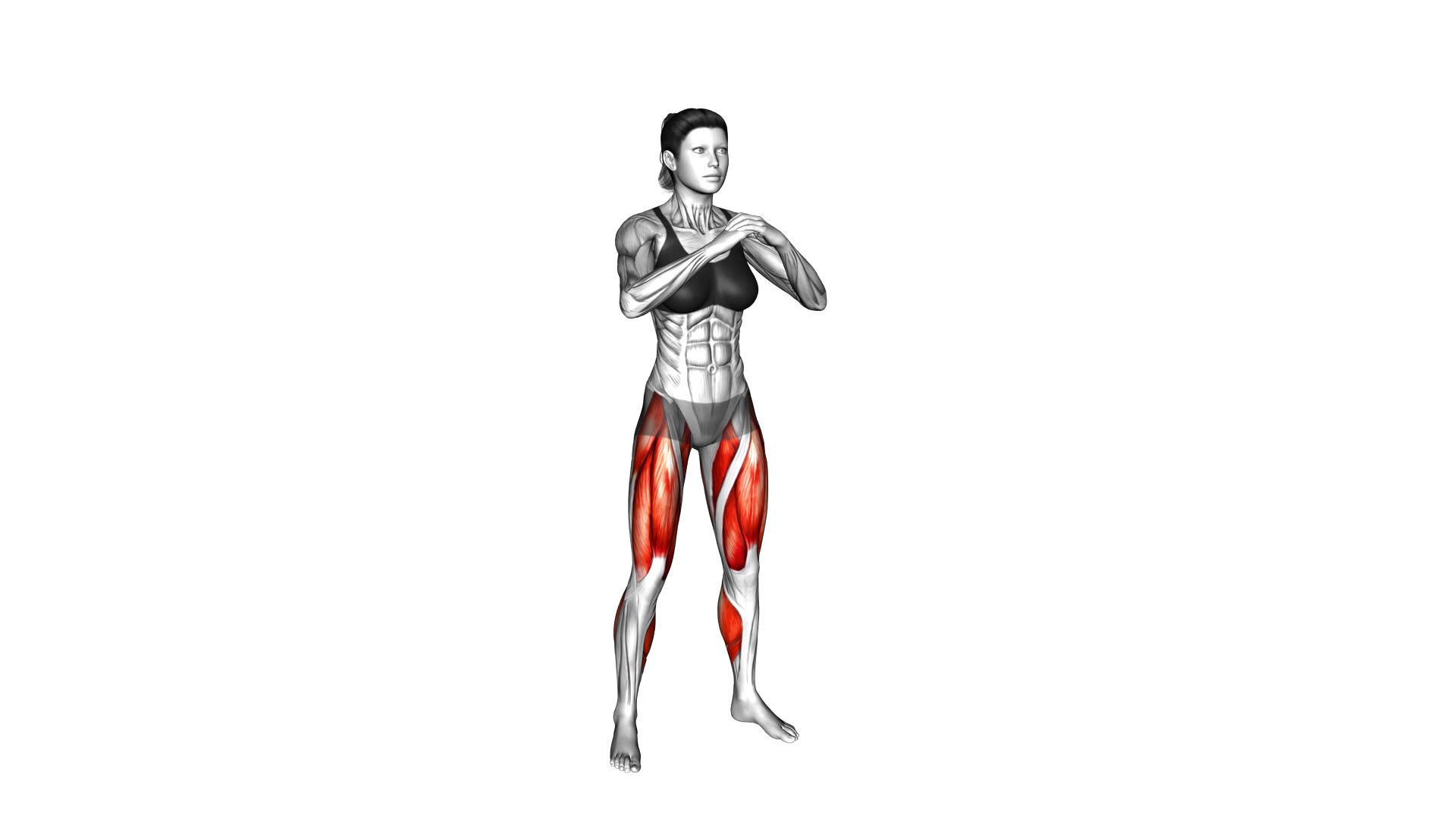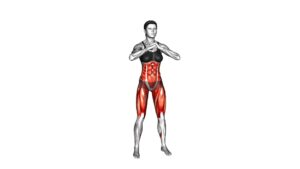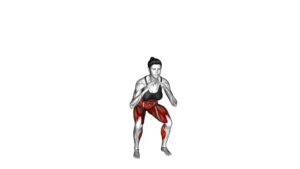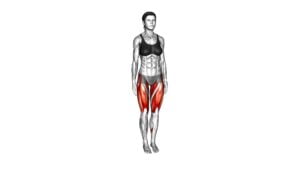Squat Side Kick (Female) – Video Exercise Guide & Tips

Are you looking to tone your lower body and improve your overall fitness? Look no further than the squat side kick!
Watch This Exercise Video
This exercise targets your glutes, thighs, and core, giving you a full-body workout.
In this video exercise guide, we'll show you the proper form and technique, as well as variations and modifications to suit your fitness level.
Avoid common mistakes and maximize your results with our helpful tips.
Get ready to kick your workout up a notch!
Key Takeaways
- The Squat Side Kick targets the glutes, thighs, and core, providing a full-body workout.
- It improves balance and stability while targeting the gluteus medius for better hip stabilization.
- Proper form and technique include maintaining a shoulder-width stance, squatting with knees in line with toes, and extending one leg out to the side while coming up from the squat.
- To maximize results, it is important to maintain proper form, engage the core, incorporate resistance, and perform the exercise at a slow and controlled pace.
Benefits of the Squat Side Kick
To maximize your workout, incorporate the squat side kick for its numerous benefits. This exercise is great for improving balance and targeting the glutes.
When performing the squat side kick, start by standing with your feet shoulder-width apart and your toes slightly turned out. Lower your body into a squat position, keeping your knees in line with your toes and your weight in your heels.
As you come up from the squat, kick one leg out to the side while keeping your core engaged and your upper body stable. Return your leg to the starting position and repeat on the other side.
By incorporating the squat side kick into your routine, you won't only strengthen your glutes, but also improve your balance and stability. This exercise is particularly effective in targeting the gluteus medius, which is responsible for stabilizing the hips and improving overall balance.
Proper Form and Technique
To perform the squat side kick with proper form and technique, focus on maintaining a stable core and engaging the glutes throughout the exercise. This will ensure that you're targeting the right muscles and maximizing the benefits of this move. Here are some key tips to help you execute the squat side kick correctly:
- Start by standing with your feet shoulder-width apart and toes slightly turned out.
- Lower into a squat position by bending your knees and pushing your hips back, keeping your chest up and your weight in your heels.
- As you come up from the squat, extend one leg out to the side, kicking it straight and engaging your glutes.
- Return to the starting position and repeat on the other side.
Common misconceptions about the squat side kick include using momentum to swing your leg and neglecting proper form. It's important to avoid these mistakes to prevent injury and ensure effective muscle activation. By maintaining a stable core and engaging your glutes throughout the exercise, you'll reap the benefits of this dynamic movement.
Variations and Modifications
Try incorporating different variations and modifications of the squat side kick to challenge your muscles and add variety to your workout routine. By introducing progression options, you can continue to challenge yourself and see continued improvement in your strength and flexibility.
One option is to increase the weight you use during the exercise, either by holding dumbbells or using a resistance band. This will add resistance and make your muscles work harder.
Another option is to increase the number of repetitions or sets you perform. This can be done by gradually increasing the number over time.
Additionally, you can try performing the squat side kick on an unstable surface, such as a balance board or a Bosu ball. This will engage your core muscles and improve your balance and stability.
To ensure injury prevention, it's important to maintain proper form and technique throughout the exercise. Engage your core and keep your back straight throughout the movement. Avoid leaning forward or rounding your back.
It's also crucial to warm up properly before performing the squat side kick. This can include dynamic stretches and movements to activate your muscles and increase blood flow.
Common Mistakes to Avoid
Avoid these common mistakes when performing the squat side kick exercise to maximize your results and prevent injury. Here are some tips for improvement:
- Lack of proper form: One of the most common mistakes isn't maintaining proper form throughout the exercise. It's important to keep your back straight, engage your core, and align your knees with your toes during the squat and kick movements. This helps prevent unnecessary strain on your joints and ensures that you're targeting the right muscles.
- Rushing the movements: Another mistake is rushing through the exercise without focusing on the quality of each movement. Take your time and maintain control throughout the squat and side kick. This will help you engage the correct muscles and get the most out of the exercise.
- Neglecting warm-up and cooldown: Many people overlook the importance of warming up before and cooling down after the squat side kick exercise. This can increase the risk of injury and decrease the effectiveness of the workout. Make sure to warm up your muscles with some light cardio and dynamic stretches before starting the exercise, and cool down with static stretches afterwards.
Tips for Maximizing Results
Maintain proper form and focus on quality movements to maximize your results with the squat side kick exercise.
To increase the intensity and effectiveness of this exercise, there are a few tips you should keep in mind.
First, make sure to engage your core throughout the entire movement. This will help stabilize your body and target your abdominal muscles.
Additionally, try incorporating resistance by using ankle weights or a resistance band. This will add extra resistance to your leg muscles, making the exercise more challenging and increasing muscle activation.
Another way to maximize your results is by performing the exercise at a slow and controlled pace. This will help you maintain proper form and ensure that you're targeting the correct muscles.
Lastly, remember to breathe properly throughout the exercise. Exhale as you kick your leg out and inhale as you bring it back in.
Frequently Asked Questions
How Many Calories Can I Burn by Doing the Squat Side Kick Exercise?
You can burn a significant amount of calories by doing the squat side kick exercise. This exercise combines the benefits of squats and kicks, targeting your lower body muscles and boosting your metabolism.
The number of calories burned will vary depending on factors like your weight, intensity, and duration of the exercise. To maximize the calorie burn, you can try different variations of the squat side kick, such as adding weights or increasing the speed.
Can I Do the Squat Side Kick if I Have Knee or Hip Problems?
If you have knee or hip problems, it's important to consult with a healthcare professional before attempting the squat side kick exercise. They'll be able to assess your specific condition and determine if it's safe for you to perform this exercise.
How Many Sets and Reps Should I Do for the Squat Side Kick Exercise?
To determine the number of sets and reps for the squat side kick exercise, consider your fitness level and goals. Generally, it's recommended to start with 2-3 sets of 10-15 reps on each leg. This helps build strength and endurance.
As you progress, you can increase the number of sets and reps to challenge yourself. Remember to listen to your body and adjust accordingly.
The squat side kick offers various benefits, such as targeting the glutes, thighs, and core. You can also explore different variations to add variety to your workout routine.
Can the Squat Side Kick Help Improve My Flexibility?
The squat side kick is a great exercise to improve your flexibility. By incorporating this move into your workout routine, you can increase your range of motion and enhance your overall mobility.
To get the most out of this exercise, remember to maintain proper form and technique. Keep your core engaged, bend your knees, and kick your leg out to the side.
With consistent practice, you'll notice significant improvements in your flexibility.
Is It Necessary to Warm up Before Performing the Squat Side Kick Exercise?
Before performing the squat side kick exercise, it's essential to warm up your muscles. Warming up helps increase blood flow, loosen muscles, and prevent injuries. It prepares your body for the workout and enhances your performance.
Additionally, warming up can provide various benefits, such as improved flexibility, increased range of motion, and better muscle activation. However, it's important to take precautions and listen to your body during the warm-up to avoid overexertion and strain.
Conclusion
In conclusion, the squat side kick is a highly effective exercise for targeting the lower body and core muscles. By maintaining proper form and technique, you can maximize the benefits of this exercise.
Remember to start with a weight that challenges you but allows for proper execution. Avoid common mistakes such as rounding the back or using momentum to swing the leg.
With consistency and dedication, you can achieve great results with the squat side kick.

Author
Years ago, the spark of my life’s passion ignited in my mind the moment I stepped into the local gym for the first time. The inaugural bead of perspiration, the initial endeavor, the very first surge of endorphins, and a sense of pride that washed over me post-workout marked the beginning of my deep-seated interest in strength sports, fitness, and sports nutrition. This very curiosity blossomed rapidly into a profound fascination, propelling me to earn a Master’s degree in Physical Education from the Academy of Physical Education in Krakow, followed by a Sports Manager diploma from the Jagiellonian University. My journey of growth led me to gain more specialized qualifications, such as being a certified personal trainer with a focus on sports dietetics, a lifeguard, and an instructor for wellness and corrective gymnastics. Theoretical knowledge paired seamlessly with practical experience, reinforcing my belief that the transformation of individuals under my guidance was also a reflection of my personal growth. This belief holds true even today. Each day, I strive to push the boundaries and explore new realms. These realms gently elevate me to greater heights. The unique combination of passion for my field and the continuous quest for growth fuels my drive to break new ground.



